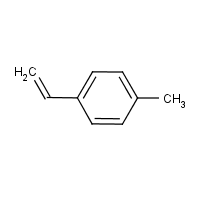4-Vinyltoluene
Agent Name
4-Vinyltoluene
CAS Number
622-97-9
Formula
C9-H10
Major Category
Other Classes

Synonyms
1-Ethenyl-4-methylbenzene; 1-Methyl-4-vinylbenzene; 1-p-Tolylethene; 4-Methylstyrene; Benzene, 1-ethenyl-4-methyl-; P-Methylstyrene; p-Methyl styrene; p-Methylstyrene; p-Vinyltoluene; Styrene, p-methyl-; para-Methylstyrene; [ChemIDplus] UN2618
Category
Aromatic Hydrocarbons
Description
Colorless liquid; [ICSC]
Sources/Uses
Used in isomeric mixture with 3-vinyltoluene as monomers for producing poly(vinyltoluene); in the production of polyester resins; to produce synthetic elastomers (co-polymerized with isobutylene); as a reactive monomer; in the coatings industry as a modifier for drying oils and oil-modified alkyds; as a replacement for styrene in unsaturated polyester resins; as a copolymer with styrene to increase the operating temperature range of paints, coatings and varnishes; [HSDB]
Comments
A skin, eye, and respiratory tract irritant; Inhalation of high concentrations may cause CNS effects; Defats the skin; May have effects on the liver and kidneys; [ICSC] Causes elevation of liver enzymes in 13 week inhalation studies of rats; [Reference #1] Vinyltoluenes, stabilized (UN2618) has warning of explosive polymerization; [ERG 2016] See "Vinyl toluene."
Biomedical References
Exposure Assessment
Vapor Pressure
1.81 mm Hg
Lethal Concentration
LC50 (rat) >3500 ppm/4h;
Explosive Polymerization
Yes
Explanatory Notes
Flash point = 52.8 deg C; [ICSC] The Guide in the Emergency Response Guidebook is for "Vinyltoluenes, stabilized." VP from ChemIDplus;
NFPA
high ambient temp required
Adverse Effects
Neurotoxin
Acute solvent syndrome
Hepatotoxin
Hepatoxic (a) from occupational exposure (secondary effect) or (b) in animal studies or in humans after ingestion
IARC Carcinogen
Not classifiable
ACGIH Carcinogen
Not Classifiable
Diseases, Processes, and Activities Linked to This Agent
Diseases
Occupational diseases associated with exposure to this agent:
Processes
Industrial Processes with risk of exposure: